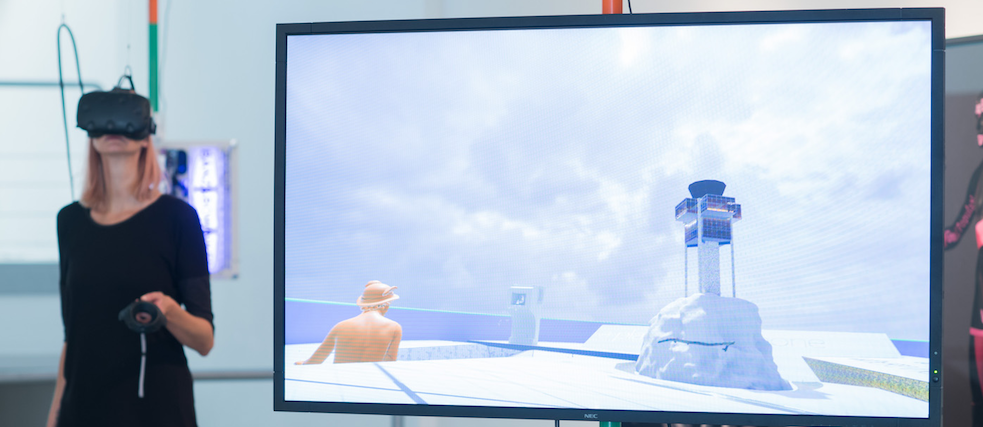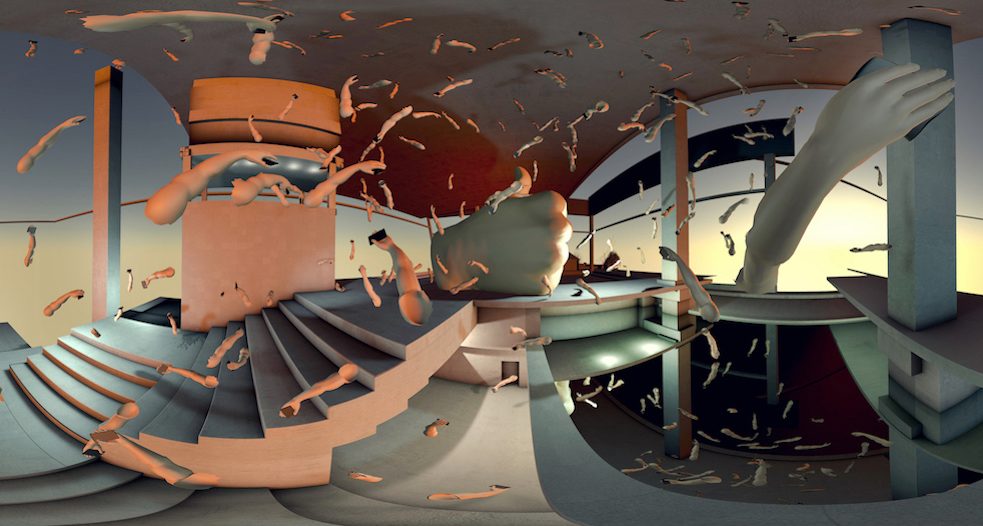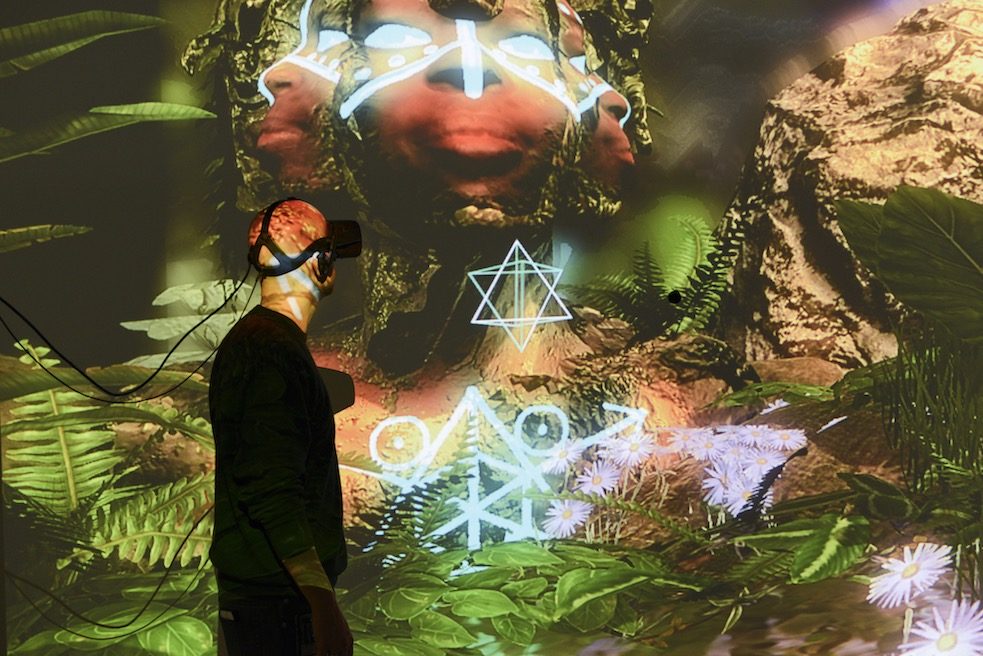VR and art
The self, the world and dissolving distinctions

Virtual reality is conquering the art scene, and more and more German artists are devoting themselves to artificial worlds. Some of the spectacular projects truly test the boundaries of perception.
By Oliver Herwig
In 2016, Thorsten Wiedemann put on a pink romper suit and entered virtual reality (VR) for a full 48 hours. For comparison, Neil Armstrong was only on the moon for 21 hours and 36 minutes. Two days can be pretty long, so Wiedemann spent his time gaming, talking, and sleeping, of course. The founder of the Berlin A Maze indie game festival virtually worked his way into a new world. He was assisted by VR designer Sara Lisa Vogl, who designed a day-night rhythm for the intronaut - and even created a sleeping cave with artificial stars. The performance piece was titled Disconnected, a combined voyage of discovery and attempt at a Guinness record, side effects included. Wiedemann told WIRED technology magazine that he had a panic attack on the very first day, and was “very close to ripping off the glasses” on the following day. Coach Vogl calmed him down though, and Wiedemann pushed through. 48 hours later, he looked into the camera with a slightly wild gaze, and fell into Sara Lisa Vogl’s arms with a big thumbs-up.
Disconnected was like an artificial world survival test, an experiment to see how long a person can be exposed to a virtual environment. It pushed the envelope to see how long a person can withstand the constant flickering of images in front of their eyes, and the comparatively low resolution of the strap-on monitor complete with the voices intruding from the ‘first’ reality.
Virtual reality art undermines our ideas of the real world. It can literally pull the rug out from under our feet by suddenly giving us the power of flight, such as in Chalkroom by Laurie Anderson and Hsin-Chien Huang. Their VR world can be experienced at the Lust der Täuschung (Thrill of Deception) exhibition at the Kunsthalle Munich until January 2019. In the VR game Richie’s Plank Experience, on the other hand, you ride up a virtual skyscraper in an elevator and then feel your way onto a free-floating wooden plank. Below is a yawning abyss that inspires wobbly knees and a case of the sweats as you realise just how easily you could virtually plunge to your death.
 The Swan Collective’s VR experience “Here We Are – A Turing Torture” will be shown at the “Touching from a distance” show curated by medienkunstverein.com in October 2018.
| Photo © the artist
The Swan Collective’s VR experience “Here We Are – A Turing Torture” will be shown at the “Touching from a distance” show curated by medienkunstverein.com in October 2018.
| Photo © the artist
Creating worlds that have never existed before
More and more artists are using VR for their work and are shaking our faith in things we’ve always taken for granted. German bit-and-byte artists are holding their own quite well in a field that is just evolving. “It’s not just about being able to move about freely; it’s about being able to create worlds that have never existed before,” says Tamiko Thiel. “This is the total work of art par excellence!” A professor at the University of Art in Linz, Thiel wants to “build virtual worlds that can be experienced as dramaturgical total works on art from the user’s perspective.”
She offered a foretaste many years ago with Transformation, an interactive installation that unearths the hidden on a stroll through Munich, such as urban streams that have disappeared under the streets. If you hold your tablet computer in front of your eyes at the correct GPS address, virtual water wheels suddenly begin rotating in a flowing stream. Augmented reality can be seen as the preliminary stage to total immersion, immersion in new worlds. It knows no limits. Or does it? “At the moment VR is delivering an experience for the eyes and ears, but not really for the other senses,” Thiel says. “Smells and the skin as a sensory organ are not involved, and neither is the kinaesthetic feeling of balance.”
International worlds, German-speaking scene
Berlin curator duo Tina Sauerländer and Peggy Schoenegge run the peer to space platform that brings VR art and artists together. They don’t see the VR medium as entirely new in art. After all, the first VR pieces (with glasses) were already around in the 1990s, created by artists like Charlotte Davies, Monika Fleischmann, and Nicole Stenger. These gave rise to a specifically German scene. Peggy Schoenegge points to artist duo Banz & Bowinkel, who won the prize for digital sculpture at the Private School of Communication and Design Stuttgart/Ulm, digital art pioneer Tamiko Thiel, who received the audience award at the VRHAM! VR art festival in Hamburg, and Manuel Roßner, who created a virtual extension for the Unreal exhibition at the NRW Forum in Düsseldorf. Then there are festivals like VRHam and A Maze, and Philip Hausmeier and Tina Sauerländer’s online research platform for VR art, RadianceVR.co.
Schoenegge is happy that large institutions are exploring the virtual and organizing a wealth of exhibitions. She predicts that, like photography and film, augmented reality, virtual reality and all forms of mixed reality will become commonplace and increasingly established over time. “Like our computers, we can use these media to enter digital worlds. We have been doing this for almost 30 years, since the beginning of the commercialization of the World Wide Web - and the internet is already an integral part of all our lives.” Schoenegge envisions a future in which we will probably spend much longer than just 48 hours embedded in virtual reality.
 A visitor experiencing Alfredo Salazar-Caro’s VR artwork “Portrait of Elizabeth Mputu” during the exhibition “THE UNFRAMED WORLD” curated by Tina Sauerländer at the House of Electronic Arts in Basel, Switzerland, in 2017.
| Photo: © Franz Wamhof
A visitor experiencing Alfredo Salazar-Caro’s VR artwork “Portrait of Elizabeth Mputu” during the exhibition “THE UNFRAMED WORLD” curated by Tina Sauerländer at the House of Electronic Arts in Basel, Switzerland, in 2017.
| Photo: © Franz Wamhof